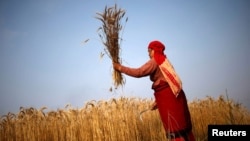The United Nations Food and Agriculture Organization (FAO) says the Asia Pacific has reached the target of reducing rates of hunger in the region, marking a key element in the U.N.’s Millennium Development Goals. While economic growth has been a primary driver in lowing rates of hunger, challenges remain to ensure progress is sustained.
The Asia Pacific, boosted by two decades of economic growth, has reduced chronic hunger and undernourishment among its populations, seen as key targets under the U.N.’s Millennium Development Goal (MDG) project to boost global development.
236 million people free from chronic hunger
On Thursday, the U.N.’s Food and Agriculture Organization said the Asia Pacific, in meeting the goal of lowering the number facing undernourishment, had lifted 236 million people from chronic hunger in the region since 1990.
The FAO’s assistant director general and Asia Pacific representative, Hiroyuki Konuma, said achieving the target and reducing the numbers of undernourished marked a historic step.
“This is a very remarkable and historical moment we are announcing that Asia Pacific has achieved the MDG hunger target," he said. "In 1990, the proportion of chronic hunger was about 24 percent and we have reached 12 percent around – that means we have halved the proportion of chronic hunger by 2015.”
Still many affected
Konuma, however, said 490 million people in the region still suffer from chronic hunger — the most of any region in the world, with the most affected including farmers, minorities, those living in isolated regions as well as people facing disabilities.
The FAO’s global report on undernourishment around the world in 2015, released in Rome, noted progress toward improved food security had continued to be uneven across regions.
China led the achievements in reducing hunger, accounting for almost two-thirds of the reduction in Asia in numbers of undernourished people in developing regions since 1990. China had also accelerated progress over the past decade.
While India had extended its food distribution program, the country’s higher economic growth failed to fully translate into higher food consumption, including better diets overall.
David Dawe, a senior FAO economist, said growth had been the main driving force for the gains in East and Southeast Asia.
“One of key determinants of food security — probably the most important one — is basically economic growth — GDP per capita and this is the reason that Asia has done so well compared to the rest of the world," he said. "GDP growth has been rapid over the past 20 to 25 years about 7.0 percent per annum compared with just 3.4 per cent for the world as a whole.”
Economic growth had also led to reduced rates of poverty from about 55 percent of the region’s population to 21 percent.
South Asian countries like Pakistan, Afghanistan, India, Sri Lanka and Mongolia reported slower progress in hunger reduction, while in the Pacific, the numbers of undernourished had risen over the period.
Young children remain serious concern
Chronic undernutrition among children under the age of 5 remains a serious concern in the region, while in South Asia and the southwest Pacific, just 40 percent of people have access to improved sanitation.
The FAO said North Korea, long faced with poor agricultural output, continued to report the most severe deterioration in levels of undernourishment.
The U.N. organization said while gains had been made, more needs to be done to eradicate hunger, including reducing income inequalities, to invest in the agriculture sector, reducing rural poverty and access to food and safe drinking water.
The FAO warned food security remained vulnerable for many, highlighted by typhoons in the Philippines, the cyclone in Vanuatu and the recent earthquake in Nepal.
Other challenges to food security include climate change, the loss of vast tracts of fertile land to urbanization, and growing competition between food crops and bio energy crops over access to land and water.










